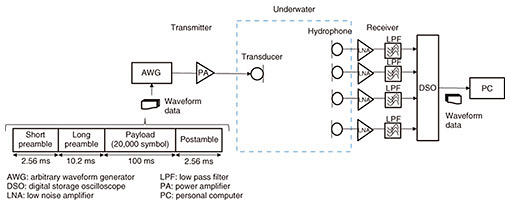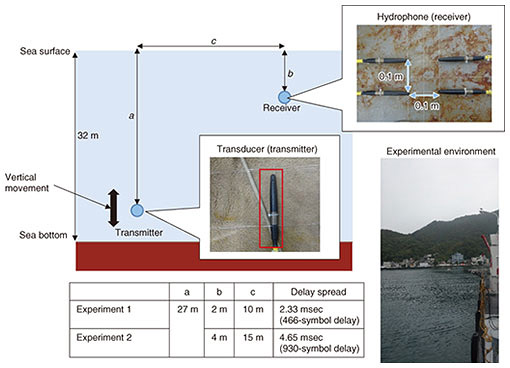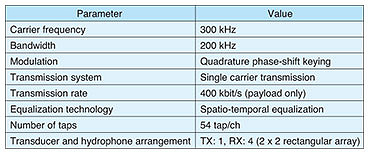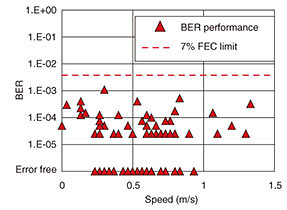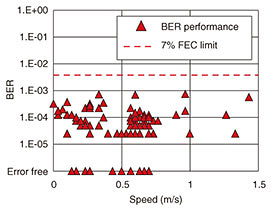 |
|||||||||||||||
|
|
|||||||||||||||
|
Regular Articles Vol. 18, No. 9, pp. 40–47, Sept. 2020. https://doi.org/10.53829/ntr202009ra1 Spatio-temporal Equalization Technology for High-capacity Underwater Acoustic CommunicationAbstractWe are currently researching and developing Mbit/s-class underwater acoustic communication technology enabling high-definition video and other large data transmission. This article proposes a spatio-temporal equalization technology, which is key for achieving high-speed underwater transmission. Keywords: underwater acoustic communication, spatio-temporal equalization, distortion compensation in double selective channel 1. IntroductionAcoustic waves have long been used by humans as a transmission medium underwater, similar to how dolphins use them. With the advantages of long communication range and not being affected by water turbidity and ambient light, acoustic communication has been applied for underwater image transmission and communication between deep-sea exploration vessels and offshore support vessels [1]. However, the communication rate with current commercial modems is only tens of kbit/s (bits per second); hence, a large amount of data, such as high-definition video, cannot be transmitted in real time [2]. Against this, we are currently researching and developing high-capacity Mbit/s-class underwater acoustic communication technologies by utilizing our expertise in wave-propagation and signal-processing technologies that have been applied to terrestrial radio wireless communication. Our technologies make it possible to transmit high-definition video and other large data, allowing full wireless remote control of undersea equipment such as remotely operated vehicles (ROVs), as shown in Fig. 1.
As a key technology to accelerate the transmission rate, this article proposes a spatio-temporal equalization technology that can provide stable distortion compensation regardless of transceiver movement or degree of double selectivity in broadband acoustic communication. 2. Underwater channel characteristics and issues regarding high-speed transmissionThe underwater acoustic channel has double selectivity, in other words, the channel impulse response varies with time. The cause is that the multipath waves generated by reflection from the sea surface, sea bottom, and underwater structures arrive at the receiver accompanied with Doppler shift due to the movement of the transceiver and fluctuation of sea surfaces, as shown in Fig. 2 [3]. Since the propagation speed of sound waves in the sea (about 1500 m/sec) is about 200,000 times slower than that of radio waves (about 3 × 108 m/sec), both degree of delay spread and that of Doppler spread of underwater channels, which are key parameters representing double selectivity, are much larger than those of land mobile radio channels. Thus, adaptive signal processing is essential for tracking time variations.
To accelerate transmission speed, we are now considering broadband acoustic transmission using a high carrier frequency of 100 kHz or more, which is rarely used in current commercial systems. Since Doppler spread increases in proportion to the carrier frequency from the viewpoint of sound propagation theory, broadband transmission, which must use a high carrier frequency, makes time selectivity stronger than that with conventional narrowband transmission systems. Thus, the state of a channel response rapidly and drastically varies even during a training period. Conventional adaptive equalization technologies, such as decision-feedback equalization [4], for estimating the inverse characteristics of the underwater channel cannot keep up with channel variation if the delay spread is less than the reciprocal of Doppler spread, as shown in Fig. 3. Therefore, there is a need for technology that can provide stable compensation regardless of transceiver movement, or degree of double selectivity, to accelerate the data transmission rate.
3. Our spatio-temporal equalization technologyThe essential diffculty with distortion compensation is estimating and tracking overall channel responses in the time or frequency domain. Thus, equalization technologies that are based on prior knowledge of the channel do not work well. The key with our spatio-temporal equalization technology is to shorten delay spread and Doppler spread by eliminating some of the delayed waves in the spatial domain before carrying out equalization in the time domain. By doing so, both delay spread and Doppler spread of the multipath channel can be made substantially smaller than those of actual channel response, as shown in Fig. 4, and this makes it possible to equalize acoustic signals through multipath channels regardless of double selectivity.
We now briefly describe the proposed spatio-temporal equalization technology. Figure 5 shows a block diagram of our technology. All the finite impulse response (FIR) filter coeffcients cascaded to each input channel are adaptively updated using adaptive algorithms, such as the recursive least squares algorithm, to minimize the square error between the desired and equalized signals. It is similar to the design of adaptive equalization [5], except for the length of the feed forward FIR filter. From the operational comparison on the left of Fig. 6, the proposed technology uses FIR filters, the filter length of which is much shorter than the actual delay spread. In this case, the signal components of the indirect path, the delays of which are longer than the length of a FIR filter, do not correlate with the desired signal. Hence, they are suppressed in the spatial domain by FIR-filter-operation updating with an adaptive algorithm. On the other hand, the signal components, the arrival delay of which is less than the length of a FIR filter, correlate with the desired signal, therefore they are equalized in the time domain, as shown at the bottom right of Fig. 6. Long-delay waves are thus cancelled in the spatial domain while equalizing residual paths in the time domain. Such a path-selective receiving structure makes stable compensation of underwater acoustic channels possible.
4. Field experimentsTo verify the effectiveness of the proposed spatio-temporal equalization technology, we conducted two transmission experiments using offline signal processing on a measurement barge moored in Suruga Bay off of Shizuoka Prefecture, Japan. We experimentally evaluated the bit error rate (BER) with respect to the speed of the vertically moving transmitter and confirmed that a stable BER can be achieved regardless of this speed or strength of double selectivity. The experimental system is shown in Fig. 7, experimental environment for both experiments (experiments 1 and 2) is shown in Fig. 8, and experimental specifications are presented in Table 1. Waveform data were recorded while the transmitter was continuously moving in the vertical direction, and the recorded data were analyzed. The mooring rope was manually moved vertically so that various speed patterns would be generated.
The observed BERs are shown in Figs. 9 and 10 for experiments 1 and 2, respectively. The horizontal axis is the speed of the vertically moving transmitter estimated using the known signal of the frame, and the vertical axis is the BERs calculated from the frame demodulation results. The BERs fluctuated regardless of the speed. This is because the level ratio of the direct wave and sea-surface reflected wave varied greatly from frame to frame due to changes on the sea surface. All the BERs were below the forward error correction (FEC) limit of 7% [6]. Also, the correlation coeffcient between speed and BER was 0.21, and there was almost no causal relationship between the deterioration in BER with respect to speed or double selectivity of the channel. Through these experiments, we confirmed the possibility of high-speed broadband acoustic transmission under actual sea conditions.
5. ConclusionIn this article, we presented our future vision for an underwater wireless communication system. Channel characteristics and issues with broadband acoustic transmission were also presented. To obtain stable compensation regardless of double selectivity, we proposed a spatio-temporal equalization technology and presented experiments conducted at sea and the results, which indicate that stable communication can be achieved regardless of speed. We also confirmed the possibility of broadband underwater communication. We mainly considered a single-input multiple-output transmission system in this article. However, multiple-input multiple-output (MIMO) extension is easy to implement thanks to the fact that our equalization technology eliminates uncorrelated interference signals simultaneously. With this property, we successfully transmitted 5.12 Mbit/s signals over 18 m using 8 × 16 MIMO transmission with offline signal processing, demonstrating the achievability of Mbit/s-class transmission. See our paper to be published [7] for a detailed description of a field experiment and a method of extending MIMO transmission. References
|
|||||||||||||||















